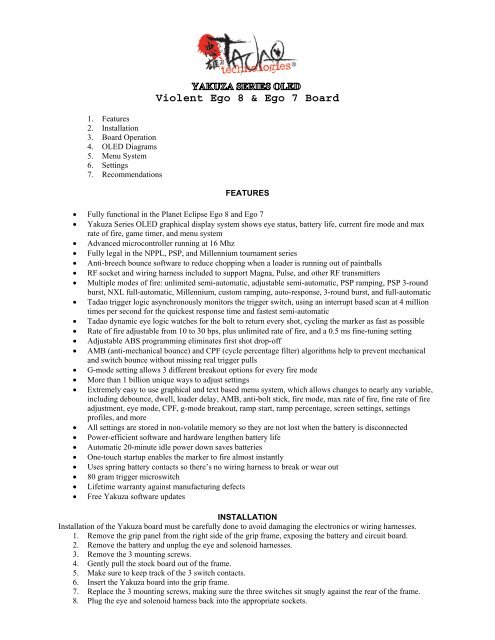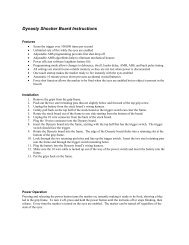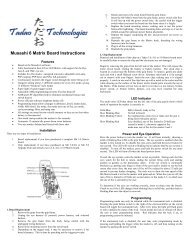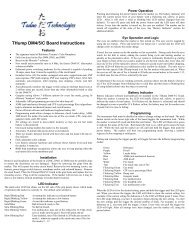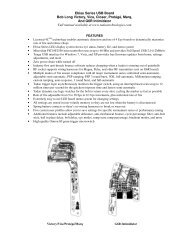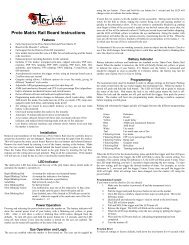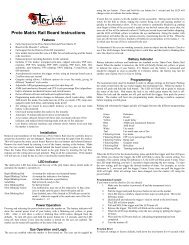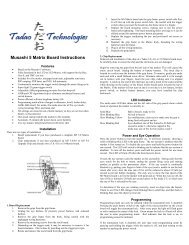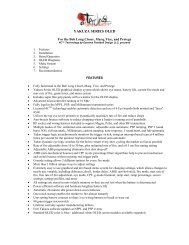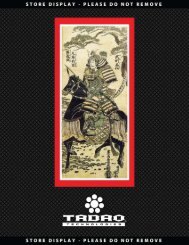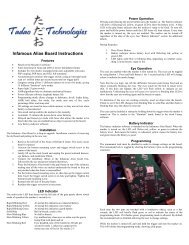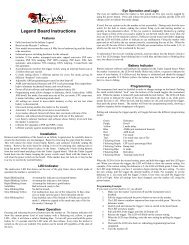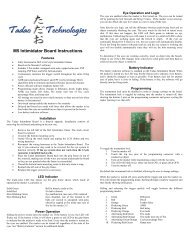Violent Ego 8 & Ego 7 Board - Tadao Technologies
Violent Ego 8 & Ego 7 Board - Tadao Technologies
Violent Ego 8 & Ego 7 Board - Tadao Technologies
Create successful ePaper yourself
Turn your PDF publications into a flip-book with our unique Google optimized e-Paper software.
1. Features<br />
2. Installation<br />
3. <strong>Board</strong> Operation<br />
4. OLED Diagrams<br />
5. Menu System<br />
6. Settings<br />
7. Recommendations<br />
<strong>Violent</strong> <strong>Ego</strong> 8 & <strong>Ego</strong> 7 <strong>Board</strong><br />
FEATURES<br />
• Fully functional in the Planet Eclipse <strong>Ego</strong> 8 and <strong>Ego</strong> 7<br />
• Yakuza Series OLED graphical display system shows eye status, battery life, current fire mode and max<br />
rate of fire, game timer, and menu system<br />
• Advanced microcontroller running at 16 Mhz<br />
• Fully legal in the NPPL, PSP, and Millennium tournament series<br />
• Anti-breech bounce software to reduce chopping when a loader is running out of paintballs<br />
• RF socket and wiring harness included to support Magna, Pulse, and other RF transmitters<br />
• Multiple modes of fire: unlimited semi-automatic, adjustable semi-automatic, PSP ramping, PSP 3-round<br />
burst, NXL full-automatic, Millennium, custom ramping, auto-response, 3-round burst, and full-automatic<br />
• <strong>Tadao</strong> trigger logic asynchronously monitors the trigger switch, using an interrupt based scan at 4 million<br />
times per second for the quickest response time and fastest semi-automatic<br />
• <strong>Tadao</strong> dynamic eye logic watches for the bolt to return every shot, cycling the marker as fast as possible<br />
• Rate of fire adjustable from 10 to 30 bps, plus unlimited rate of fire, and a 0.5 ms fine-tuning setting<br />
• Adjustable ABS programming eliminates first shot drop-off<br />
• AMB (anti-mechanical bounce) and CPF (cycle percentage filter) algorithms help to prevent mechanical<br />
and switch bounce without missing real trigger pulls<br />
• G-mode setting allows 3 different breakout options for every fire mode<br />
• More than 1 billion unique ways to adjust settings<br />
• Extremely easy to use graphical and text based menu system, which allows changes to nearly any variable,<br />
including debounce, dwell, loader delay, AMB, anti-bolt stick, fire mode, max rate of fire, fine rate of fire<br />
adjustment, eye mode, CPF, g-mode breakout, ramp start, ramp percentage, screen settings, settings<br />
profiles, and more<br />
• All settings are stored in non-volatile memory so they are not lost when the battery is disconnected<br />
• Power-efficient software and hardware lengthen battery life<br />
• Automatic 20-minute idle power down saves batteries<br />
• One-touch startup enables the marker to fire almost instantly<br />
• Uses spring battery contacts so there’s no wiring harness to break or wear out<br />
• 80 gram trigger microswitch<br />
• Lifetime warranty against manufacturing defects<br />
• Free Yakuza software updates<br />
INSTALLATION<br />
Installation of the Yakuza board must be carefully done to avoid damaging the electronics or wiring harnesses.<br />
1. Remove the grip panel from the right side of the grip frame, exposing the battery and circuit board.<br />
2. Remove the battery and unplug the eye and solenoid harnesses.<br />
3. Remove the 3 mounting screws.<br />
4. Gently pull the stock board out of the frame.<br />
5. Make sure to keep track of the 3 switch contacts.<br />
6. Insert the Yakuza board into the grip frame.<br />
7. Replace the 3 mounting screws, making sure the three switches sit snugly against the rear of the frame.<br />
8. Plug the eye and solenoid harness back into the appropriate sockets.
9. Replace the battery. The positive terminal is towards the front of the frame, as shown by the + and – marks<br />
on the surface of the board.<br />
10. Replace the grip panel.<br />
BOARD OPERATION<br />
Turn on the board by pushing the middle button. The OLED display will show the boot screen, followed by the<br />
main screen with the current fire mode, rate of fire, battery, and eye status visible.<br />
Turn off the board by pressing and holding the middle button for at least 1 second. The OLED display will turn off<br />
to indicate the board has shut down.<br />
The eye system is toggled on and off by pressing and holding the top button. The OLED display will reflect the eye<br />
status by changing the eye indicator and maximum rate of fire symbol or value.<br />
If used, the eye system cycles the marker as fast as possible. During each shot the eyes watch for the bolt to return,<br />
ending the current firing cycle and starting another as quickly as the pneumatics allow. If the eye system is<br />
continually blocked (e.g., putting your finger in front of the eyes) and is unable to see the bolt return after every<br />
shot, the max rate of fire will be reduced to about 8 balls per second to prevent further chopping, and the OLED<br />
screen will display an eye malfunction. Firing the marker with paint and air will utilize the eye system correctly,<br />
maximizing the rate of fire.<br />
The programming menu system is activated by holding down the trigger while pressing the middle button. The<br />
OLED display will show “Menu system initiated….” Further details regarding the menu system can be found<br />
below.<br />
If selected in the menu system, the game timer will replace the current rate of fire indicator on the OLED display.<br />
The game timer can be started by pressing bottom button while the timer is displayed.<br />
OLED DIAGRAMS<br />
The OLED display built into the Yakuza series board shows the user a multitude of information via text and icons.<br />
The software is written with performance in mind, and will not update the screen until the user stops shooting for<br />
just a fraction of a second. This ensures that screen updates do not interfere with the timings of the marker.<br />
Main screen showing rate of fire: Main screen showing game timer (when enabled):<br />
The battery indicator shows battery life by displaying bars within the icon. The more bars, the higher the battery<br />
level. A low battery (1 bar) is reached at approximately 7.5 volts, but if quality alkaline batteries are used, the<br />
remaining power should be adequate for at least 1 more case of paint.<br />
The eye indicator is displayed as a circular icon, showing the eye status. If the eye system has a malfunction from<br />
not seeing the bolt return, it will show a circle with an X.<br />
Empty breech: Eyes blocked:<br />
Eye malfunction, bolt not seen returning: Eyes off:<br />
MENU SYSTEM<br />
The Yakuza menu system allows the user to quickly and easily change a multitude of settings. The text based menu<br />
is much faster and easier to understand than LED based programming modes.<br />
Tournament lock: The tournament lock can be toggled on and off by pressing the small switch located just below<br />
the eye and solenoid sockets on the surface of the board while the marker is turned off. Each press will disable or<br />
enable the tournament lock, and display the lock status on the OLED screen.
Programming mode: To boot into programming mode the tournament lock must be off. The user can then hold<br />
down the trigger while pressing the power switch to boot into programming mode. After the menu boot message,<br />
the displayed setting will be the last one that was modified. If this is the first time the board has been booted into the<br />
menu system, it will show the fire mode.<br />
Scroll forward or backward through the settings by pressing and releasing the top or bottom buttons. The menu will<br />
wrap around to the beginning when the last setting is reached.<br />
To change a setting the user must quickly press and release the middle switch. The OLED screen will reflect this by<br />
displaying “set” in front of the current value. The setting can be modified at this point by pressing either the top or<br />
bottom buttons to increment or decrement the current value. After the desired value is displayed, you can save the<br />
setting by pressing the power switch. The “set” designation next to the value will disappear.<br />
Example to change the maximum rate of fire from 15 to 20:<br />
1. Boot into programming mode by holding the trigger while pressing the power switch.<br />
2. The first setting is fire mode:<br />
3. Press the bottom button 1 time to advance to the next setting, which is the maximum rate of fire:<br />
4. Press and release the power button quickly. The OLED screen will display the “set” designation next to the<br />
current value for maximum rate of fire:<br />
5. Press the top button 5 times to increment the value from 15 to 20:<br />
6. Press and release the power button quickly. The OLED screen will remove the “set” designation from view<br />
and save the setting:<br />
7. Cycle through additional settings using the top and bottom buttons, or exit programming mode by holding<br />
the power switch for 1second, until the OLED screen turns off.<br />
SETTINGS<br />
Fire mode (default semi-automatic unlimited)<br />
1. Semi-automatic unlimited<br />
2. Semi-automatic adjustable<br />
3. PSP ramping – 123 shots semi, on 4 th shot ramps at 5 pulls per second, resets after 1 second<br />
4. PSP burst – 123 shots semi, on 4 th shot fires 3-round burst, resets after 1 second<br />
5. NXL full-automatic – 123 shots semi, on 4 th shot fires full-automatic, resets after 1 second<br />
6. Millennium ramping – 123 shots semi, on 4 th shot ramps at 6 pulls per second, ignores ramp start<br />
setting if less than 6 pulls per second, resets after 1 second<br />
7. Custom ramping – user adjustable ramping, select custom ramp start and ramp percentage<br />
8. Auto response – fires on each pull and release<br />
9. Burst – 3-round burst<br />
10. Full-automatic – 1 shot semi, on 2 nd shot fires full-automatic, resets after 1 second<br />
Maximum rate of fire (default 13 bps, range 10-30 and infinity)<br />
The semi-automatic unlimited fire mode ignores this value, making it easy to switch back and forth between NPPL<br />
and PSP gun rules without modifying more than one setting. Adjustable from 10 to 30, with an unlimited option<br />
designated by the infinity symbol.<br />
Fine rate of fire timing (default 0.0, range -2.5 to +2.5)<br />
Allows fine adjustment of the maximum rate of fire in 0.5 millisecond increments, from -2.5 to +2.5 milliseconds.
Game timer (default off, range 1-20)<br />
Enables and sets the game timer, which replaces the rate of fire indicator on the OLED display when turned on.<br />
The game timer is adjustable from 1 to 20 minutes, and automatically adds the 10-second countdown prior to game<br />
start. For game timer use please refer to the <strong>Board</strong> Operation section.<br />
Debounce (default 10 ms, range 1-25)<br />
The amount of time the trigger must be released for the microcontroller to allow the next trigger pull. The Yakuza<br />
series uses an asynchronous interrupt-based scan at 4 million times per second that is run independently from code<br />
execution. This ensures that every trigger pull is registered. Higher values reduce bounce. Lower values cause<br />
more bounce.<br />
Anti-mechanical bounce (default 1, range 1-4)<br />
Helps eliminate mechanical bounce which can cause a loosely held paintball marker to go full-auto when the trigger<br />
is pulled slowly.<br />
Cycle percentage filter (default 2, range 1-10)<br />
Secondary debounce filter which adjusts how far into the firing cycle additional buffered shots are allowed. A<br />
setting of 1 turns this filter off, while settings 2 through 10 set the percentage of the cycle that must pass before shots<br />
may be buffered. Higher settings will reduce bounce.<br />
Dwell (default 14 ms, range 2-25)<br />
The amount of time the solenoid is energized during each firing cycle. Low dwell times can lead to inconsistency<br />
and drop-off. High dwell times can cause bad air efficiency.<br />
Anti-bolt stick (default off, range 1-10)<br />
Bolt stick can occur when the o-rings in the bolt settle or stick, causing the next shot to have lower velocity. If the<br />
marker is left sitting for more than 20 seconds, ABS adds extra dwell to ensure the next shot has proper velocity.<br />
The default is off.<br />
BIP delay (default 1, range 1-10)<br />
A slight delay that allows each paintball to settle in the breech before firing. Lower settings potentially lead to<br />
higher achievable rates of fire.<br />
Bolt delay (default 10, range 1-15)<br />
A delay time that gives the bolt enough time to block the eyes on the forward stroke. Too low of a bolt delay will<br />
cause blank or skipped shots. Too high of a setting can limit the maximum rate of fire.<br />
Eye mode (default forced)<br />
1. Forced with force shot – marker only fires when a paintball is present, unless a force shot is initiated by<br />
holding down the trigger for ½ second.<br />
2. Delayed – the eyes will watch for a paintball for up to 500 ms after each pull, then fire. This is useful for<br />
sound activated loaders and was the stock setting on original Intimidators.<br />
Ramping start (default 5, range 4-14)<br />
Adjusts how fast a user must pull for the ramping fire modes to start adding additional shots. Used with the PSP<br />
ramping, Millennium ramping, and custom ramping fire modes.<br />
Ramping percent (default 500%, range 10%-500%)<br />
Adjusts how much the software helps the user. A 50% ramp will add 50% of the user’s pulling rate to the current<br />
rate of fire (e.g., if you pull 8 times per second, it will add an additional 50%, meaning the gun will fire 12 times per<br />
second).<br />
G-mode or “breakout mode” (default off)<br />
This breakout setting provides unlimited full-auto, which then falls back to the user-selected fire mode, on the 1 st ,<br />
2 nd , or 3 rd shot after turning the board on. Breakout modes are illegal for use in all tournament series and most<br />
recreational paintball fields. <strong>Tadao</strong> <strong>Technologies</strong> LLC takes no responsibility if a player chooses to use<br />
breakout modes.<br />
Screen Orientation (default left)<br />
Allows the user to configure the orientation of the screen. Available options are left and right landscape, or vertical.<br />
Rate of fire/Timer size (default big)
Allows the user to pick the text size for the current rate of fire or game timer display on the OLED screen. The<br />
available options are “normal” and “big”, and only apply to the landscape screen orientation settings.<br />
Rate of fire display mode (default maximum)<br />
1. Maximum – displays the highest achieved rate of fire based on the shortest time between any 2 shots.<br />
2. Average – displays the average rate of fire of the last 5 shots.<br />
Brightness (default 5, range 1-5)<br />
Allows adjustment of the OLED display brightness. Lower settings are less bright, with a setting of 1 useful for<br />
night play and scenario games.<br />
Save profile<br />
Allows the user to save his current settings in one of 3 profiles which are not deleted by a settings reset.<br />
Load profile<br />
Allows the user to load any previously saved settings profiles.<br />
Reset<br />
Allows the user to perform a settings reset, which returns all settings to their default values. Saved profiles will not<br />
be reset.<br />
Version<br />
Displays the current software version running on the Yakuza series board.<br />
RECOMMENDATIONS<br />
Settings<br />
The Yakuza series ship with default settings which are tuned for a wide range of trigger adjustments and general<br />
usage. Certain tournament series allow alternate fire modes with specific characteristics, so the following is a list of<br />
settings that will give you a baseline. Ultimately, every marker is unique and may require different settings for<br />
optimal performance.<br />
NPPL: Use the default settings, possibly only changing debounce, AMB, and CPF to suit your personal trigger<br />
adjustments.<br />
PSP: Use the PSP ramping or PSP burst fire modes, with maximum rate of fire set to the required cap for the league<br />
(for 2007 this was 15 bps). Make sure debounce is near default values.<br />
NXL: Use the NXL full-automatic or PSP fire modes. See PSP for maximum rate of fire recommendations.<br />
Millennium: For 2008 the Millennium series modified their rules slightly. It is now a 12 bps cap with a 6 pulls per<br />
second activation, and requires the 1-2-3 semi-auto shots like PSP mode before ramping can begin.<br />
Use the specific Millennium mode. The ramp start will automatically be set to 6 pulls per second as required by the<br />
Millennium series unless a higher value is selected. Maximum rate of fire must be manually set to 12 bps.<br />
Many European tournaments besides the Millennium series utilize semi-automatic, but capped at 15 bps. Select the<br />
capped semi-automatic fire mode for these events.<br />
Care and cleaning<br />
Your Yakuza series board includes a conformal coating to help protect against damage caused by moisture such as<br />
broken paint or rain. Under normal conditions the board should continue to operate, even with small amounts of<br />
moisture present. However, paint is slightly corrosive and can destroy the conformal coating over time. In the event<br />
that you get broken paint or water on the electronics, unplug the battery and use rubbing alcohol and a blast of<br />
compressed air to clean the board off. The compressed air will ensure that everything is cleaned out from beneath<br />
the components and connectors.<br />
Batteries<br />
<strong>Tadao</strong> <strong>Technologies</strong> recommends the use of quality alkaline batteries such as those made by Duracell and Energizer.<br />
Photo lithium 9 volt batteries are also adequate. Batteries labeled as “heavy duty” or “super heavy duty” are not true<br />
alkaline and will cause inconsistent operation, or may not properly power the electronics. Rechargeable batteries are<br />
also not recommended because they typically do not provide enough current.
Trigger adjustment and switch life<br />
The trigger switch used on the Yakuza series boards is a high quality tactile lever switch made by Omron. It has a<br />
life expectancy of several million actuations. The life of a trigger switch on a paintball marker can be substantially<br />
shortened by using too short of a trigger pull. It is imperative to have at least a tiny amount of travel before and after<br />
the actuation point. It is also extremely important to use some kind of trigger return force, such as a spring or<br />
magnet. Excessive bounce may occur if a spring or magnet is not used, or if the actuation point is too close to the<br />
beginning or end of the trigger pull.<br />
Additional information at www.tadaotechnologies.com


